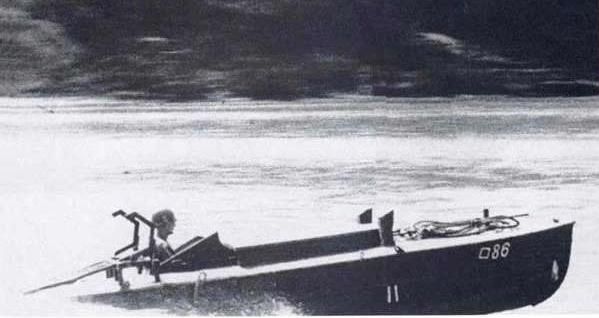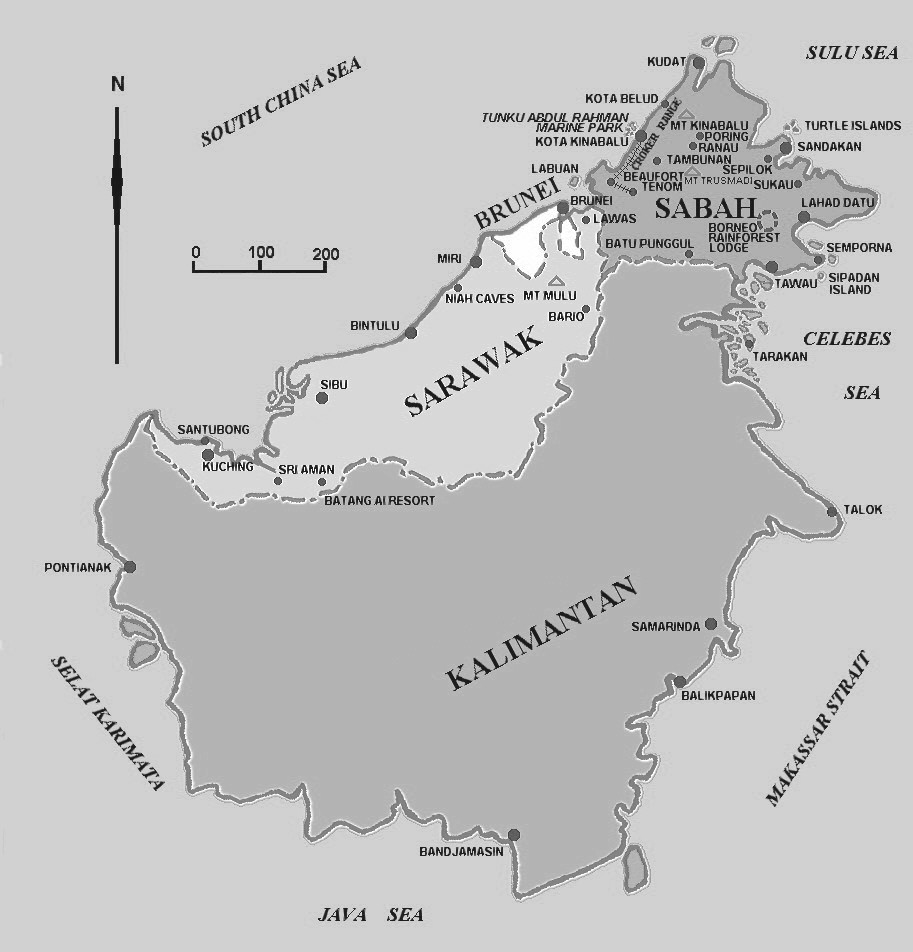SHINYO!
 (Captured EMB under test by an American
soldier)
(Captured EMB under test by an American
soldier)
Explosive Motorboats based at
Sandakan, North Borneo,
1944-1945
© 2010 Bob Hackett and Sander Kingsepp
 Map of Borneo showing Sandakan in NE Sabah
18 January 1942: - The Seizure of British North Borneo:
Map of Borneo showing Sandakan in NE Sabah
18 January 1942: - The Seizure of British North Borneo:
After completing successful invasions in December and seizing the oilfields at Miri in Sarawak and Seria in Brunei, MajGen Kawaguchi Kiyotake orders LtCol Watanabe to capture Sandakan, the capital of British North Borneo. Watanabe, using ten small fishing boats carrying the majority of two infantry companies, lands at Sandakan. His men quickly disarm the 650-man Armed Constabulary and free 600 interned Japanese citizens. The next morning, Governor Robert Smith surrenders the State of North Borneo and is interned with his staff.
8 July 1942:
1500 Australian and British prisoners of war (POW) are sent from Changi POW Camp at Singapore to POW Camp No. 1 at Sandakan under the command of Captain Hoshijima Susumito. They are put to work building two airstrips and roads to supply them. After their first year at Sandakan, the POWs suffer terribly from starvation, overwork and disease.
April 1943:
A further 776 British POWs arrive and are placed in Sandakan's Camp 2.
June 1943:
500 Australian POWs arrive and are placed in Sandakan's Camp 3.
September 1944:
Lt Aita Hideo's untrained 300-man 6th Special Attack Shinyo Squadron and 48 crated Shinyo explosive motorboats (EMBs) are sent to Manila, Philippines aboard two unidentified oil tankers. By early October, the squadron is based at Zamboanga, Mindano and begins training.
October 1944:
Under continous threat of American air attacks, the 6th Shinyo Squadron is withdrawn from Zamboanga and transported to Sandakan, Sabah, NE Borneo. The squadron establishes its base on a small, swampy island on Sandakan Bay, but even here Allied planes raid Sandakan and the airfields. The 6th Shinyo Squadron is the only IJN unit at Sandakan.
20 October 1944: American Operation "KING TWO" - The Invasion of Leyte, Philippines:
Admiral (later Fleet Admiral) William F. Halsey's (former CO of SARATOGA, CV-3) Third Fleet, of 738 ships including 18 aircraft carriers, six battleships, 17 cruisers, 64 destroyers and over 600 support ships, lands the Army's X and XXIV Corps that begin the campaign to retake Leyte.
 Philippines
(U.S. Army)
Philippines
(U.S. Army)
January - 15 August 1945:
By the beginning of 1945, many POWs have died in Japanese captivity. The POWS are ordered to march into the mountains to an isolated base at Ranau. A series of three such "death marches" results in the deaths of more than 3,600 Indonesian civilian slave laborers and 2,428 Australian and British POWs. Nearly 300 men, too sick to attempt the marches, either die or are executed at Sandakan. Of the hundreds of POWs, only six men – all Australians - escape during the marches, and are later rescued by Allied forces. [1][2]
27 May 1945:
A massive Allied sea-air bombardment of Sandakan occurs. Japanese survivors from ships sunk in the harbor come ashore and kill any local people they find.
As a result of the Oct '44 invasion of Leyte, the 6th Shinyo Squadron was trapped at Sandakan for the duration of the war. By war's end, about 170 of the squadron's men die of malaria, other tropical diseases and malnutrition. Only about 30 men are KIA, probably either in USAAF bombing attacks or the bombardment
of Sandakan. The 6th Shinyo Squadron never makes an attack using its EMBs.
15 August 1945: Cessation of Hostilities:
Imperial Palace, Tokyo. At noon, the Emperor announces Japan's surrender that is broadcast by radio all over the Japanese Empire.
Ranau, Borneo. Many Japanese refuse to surrender and the killing of POWs by beheading, shooting or bayoneting continues weeks after the end of the war. The war crimes interrogation of Captain Hoshijima reveals that the last POWs were killed at Ranau on 27 August 1945, well after the Japanese surrender. Undoubtedly, they were killed to stop them testifying to the atrocities committed by the guards.
9 September 1945:
Morotai, Halmaheras, Molucca Islands. LtGen Teshima Fusataro, C-in-C, Japanese Second Army, signs the instrument of surrender of all Japanese forces remaining in Borneo and the Netherlands East Indies east of Lombok Island (about 126,000 men). General (later Field Marshal) Sir Thomas Blamey, C-in-C, Allied Land Force, South West Pacific Area, accepts the surrender from Teshima who also surrenders his Shin-Gunto samurai sword (with general officer's knot).
 Gen Blamey (left) accepts LtGen Teshima's surrender
(Australian War Memorial)
27 August 2010:
Gen Blamey (left) accepts LtGen Teshima's surrender
(Australian War Memorial)
27 August 2010:
Lismore, New South Wales, Australia. 65 years to the day since the last POW was murdered, Governor-General Ms Quentin Bryce dedicates a memorial to the victims of the Sandakan death camp and its death marches.
 Gov-Gen Bryce unveils the Sandakan Memorial
Gov-Gen Bryce unveils the Sandakan Memorial
Authors' Note:
[1] Although the Sandakan "death marches" are considered to be the worst atrocities suffered by Australian servicemen during World War II, little was known about the subject until 1998, when author Lynette Silver broke the "conspiracy of silence" (between the GOJ and the GOA, now major trading partners) which had lasted 53 years.
[2] Brutality and maltreatment of POWs apparently were not confined solely to the Japanese. One western author claims that of 21,000 Japanese who surrendered to Australian troops in North Borneo only a few hundred survived a "death march" to Beaufort on the west coast.
-Bob Hackett and Sander Kingsepp
Back to Explosive
Motorboats Page









